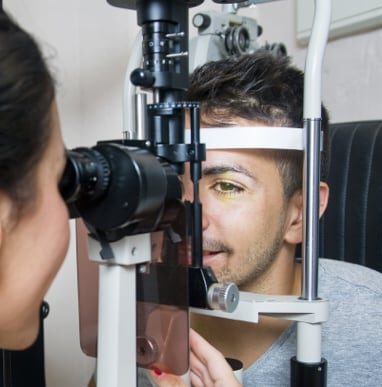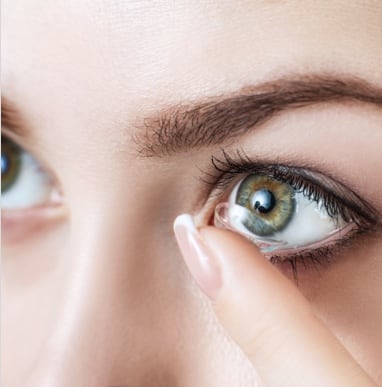In our information-heavy world, reading is an essential skill for work, play, and connecting with others. However, for some people, reading can present unique challenges. Recent studies suggest that eye tracking problems may contribute to reading difficulties.
Eye tracking problems can make it hard to keep your place on a page and move from one sentence to the next. These issues may also lead to accidentally adding or missing words when reading, making comprehension more difficult.
Luckily, eye care professionals can help improve eye tracking through treatments like vision therapy. This can lead to improved reading, academics, and confidence.
What Is Eye Tracking?
Eye tracking refers to how well your eyes can focus on items and follow visual paths. When we read, our eyes, and the muscles that control the eyes must coordinate to allow our eyes to move smoothly.
For reading specifically, this means following lines of text across a page while focusing briefly on each word. Eye tracking allows us to recognize words quickly, stay on the right line, and make sense of entire sentences. If our eyes struggle to follow text, reading can be difficult and frustrating.
Eye tracking issues can manifest in a number of ways. Some people might skip words or lines, while others may struggle to maintain their place on the page. These challenges are often linked to underlying visual or neurodevelopmental conditions. Such issues can significantly impact academic performance and self-esteem, so it’s important to address them early on.
Signs of Eye Tracking Problems
When eye tracking is disrupted, the brain receives incomplete or confusing information. This can lead to many different issues in reading. Eye tracking problems often manifest as physical signs or reading difficulties.
Some common reading difficulties for people with eye tracking are:
- Difficulties recognizing words and letters
- Below average reading fluency for their age
- Frequently losing a place on a page
- Reading the same lines repeatedly
- Difficulties reading out loud without mistakes
- Poor focus during tasks that require reading
- Using a finger to keep a place on a page
- Struggling to copy down notes in class
Some common physical signs of eye tracking problems include:
- Headaches
- Fatigue
- Eye rubbing
- Closing one eye while reading
How Eye Tracking Affects Reading
Reading fluency allows us to comprehend and enjoy written text. It involves the ability to read text accurately, quickly, and with appropriate expression. Eye tracking problems can disrupt fluency by causing frequent pauses, misinterpretation of words, and difficulty maintaining a steady reading pace.
For readers, this can be incredibly frustrating. When the eyes struggle to track words smoothly, the brain works harder to fill in the gaps, leading to mental overload. This not only slows down reading speed. but also affects comprehension, as the reader’s focus shifts from understanding content to decoding each word.
Impacts on Academic Performance and Self-Esteem
Studies have shown links between reading abilities and academic performance. Students who struggle with reading may struggle to read instructions for exams and assignments or to copy down notes displayed at the front of the class. This puts students with eye tracking problems at a disadvantage compared to their peers.
Over time, reading difficulties can contribute to a negative self-image and a reluctance to participate in classroom activities. This, in turn, can lead to mental health struggles like anxiety—which just goes to show the profound impacts that eye tracking problems can have on people’s lives.
How Are Eye Tracking Problems Diagnosed?

Fortunately, there are several diagnostic tools and tests available to identify eye tracking problems. Behavioral optometrists and vision therapists specialize in assessing visual skills and can conduct comprehensive evaluations to diagnose eye tracking issues. These assessments often involve tracking eye movements, evaluating focusing abilities, and analyzing visual processing skills.
Through these evaluations, professionals can identify specific areas of concern and use vision therapy to help reduce eye tracking difficulties. Early diagnosis and intervention can significantly improve reading abilities, providing individuals with the support they need to thrive academically and personally.
Addressing Eye Tracking Issues
Vision therapy is a common approach to treating eye tracking problems. Vision therapy uses exercises that strengthen the muscles around the eyes and enhance their coordination. Improving these abilities allows a person’s eyes to get better at focusing and moving smoothly, improving eye tracking.
In addition to vision therapy, eyeglasses can provide additional support and assistance. Therapeutic eyeglasses typically provide magnification and supportive prism to aid the person’s eye muscles. Eyeglasses alone do not change how the eye muscles work, but they can provide a layer of assistance complementary to the vision therapy.
In addition to vision therapy, additional academic accommodations can make reading more accessible. These include using larger print, providing additional time for reading tasks, and incorporating assistive technology such as text-to-speech software. By creating a supportive reading environment, we can help those who are lagging behind develop their confidence and proficiency.
Personalized Solutions for Eye Tracking Problems
Understanding the connection between eye tracking and reading fluency allows people to take steps to address reading challenges. Early diagnosis, effective interventions, and a supportive community can transform the reading experience, empowering people to achieve academic success and personal growth.
At Vision Care Center, we offer customized vision therapy plans to help you meet your unique visual and reading needs! Book an appointment with us today!











